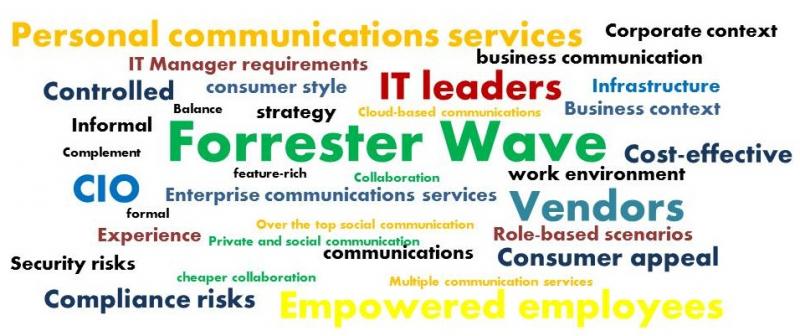Personal Communication Services and Social Collaboration Are Entering The Workplace
 By Dan Bieler and Enza Iannopollo
By Dan Bieler and Enza Iannopollo
Personal communications services, which we define as communication and collaboration services that merge private, social and business communication in one personal view, are becoming part of the work environment. Services like Skype or Google Apps allow users to speak and send messages across multiple communications services to communicate and collaborate just as they would as consumers within a corporate context. Empowered employees expect to use these collaboration channels not just for personal use but also for work.
Although Skype has been around for more than decade, the market for personal communications services in a business context is still very much evolving. The personal communication experience is complex and challenging, as individuals wrestle with multiple communications services to manage an increasingly diverse set of communication and collaboration technologies.
Personal communications offers CIOs a cost-effective, feature-rich, and informal communication environment. However, they also potentially conflict with the CIO’s interest in controlled and formal communication solutions — not to mention security and compliance risks. But IT leaders are under pressure to provide safe and innovative communications infrastructure. Hence, we believe that none of these parties can afford to ignore the opportunities for better or cheaper collaboration. In fact, our research indicates that the adoption of these over-the-top social communications services is a top telecom priority.
Therefore, the right strategy for dealing with social cloud communications services matters to business. In a new emerging markets Forrester Wave evaluation (The Forrester Wave™: Personal Communications Services, Q3 2013), we aim to assist the CIO in deciding which personal communications services are best positioned for the business environment.
We evaluated 10 significant providers of personal communications services along 41 criteria (Cisco, Facebook, Google, Jitsi, LogMeIn, Rebtel, RingCredible, Microsoft, T-Mobile, and Yeloworld). The evaluation criteria incorporate both consumer appeal and IT manager requirements. We readily acknowledge our list of vendors is by no means exhaustive and that no two cloud-based communications and collaboration solutions are alike.
In the evaluation, we present weightings of the criteria that reflect three different role-based scenarios: one for the empowered employees, one for the IT manager, and one for the CIO. The empowered employees want to, and are allowed to, use personal communications services at work in a similar fashion as they do privately. The IT manager is keen to reduce costs and complement or partly replace traditional communications infrastructure with personal communications infrastructure. And the CIO wants to bring innovative value to the empowered employees but needs to balance the innovative benefits that personal communications services bring with features that minimize their risks to security and compliance.
Clearly, a particular business context needs to be reflected in the personal communications services strategy. Hence, each Forrester customer needs to balance the various collaboration usage scenarios and define his or her own weighting of the criteria based on the business requirements. Of course, personal communications will not replace but complement enterprise communications services. However, “The Forrester Wave™: Personal Communications Services, Q3 2013” will help CIOs to prepare for this process.
